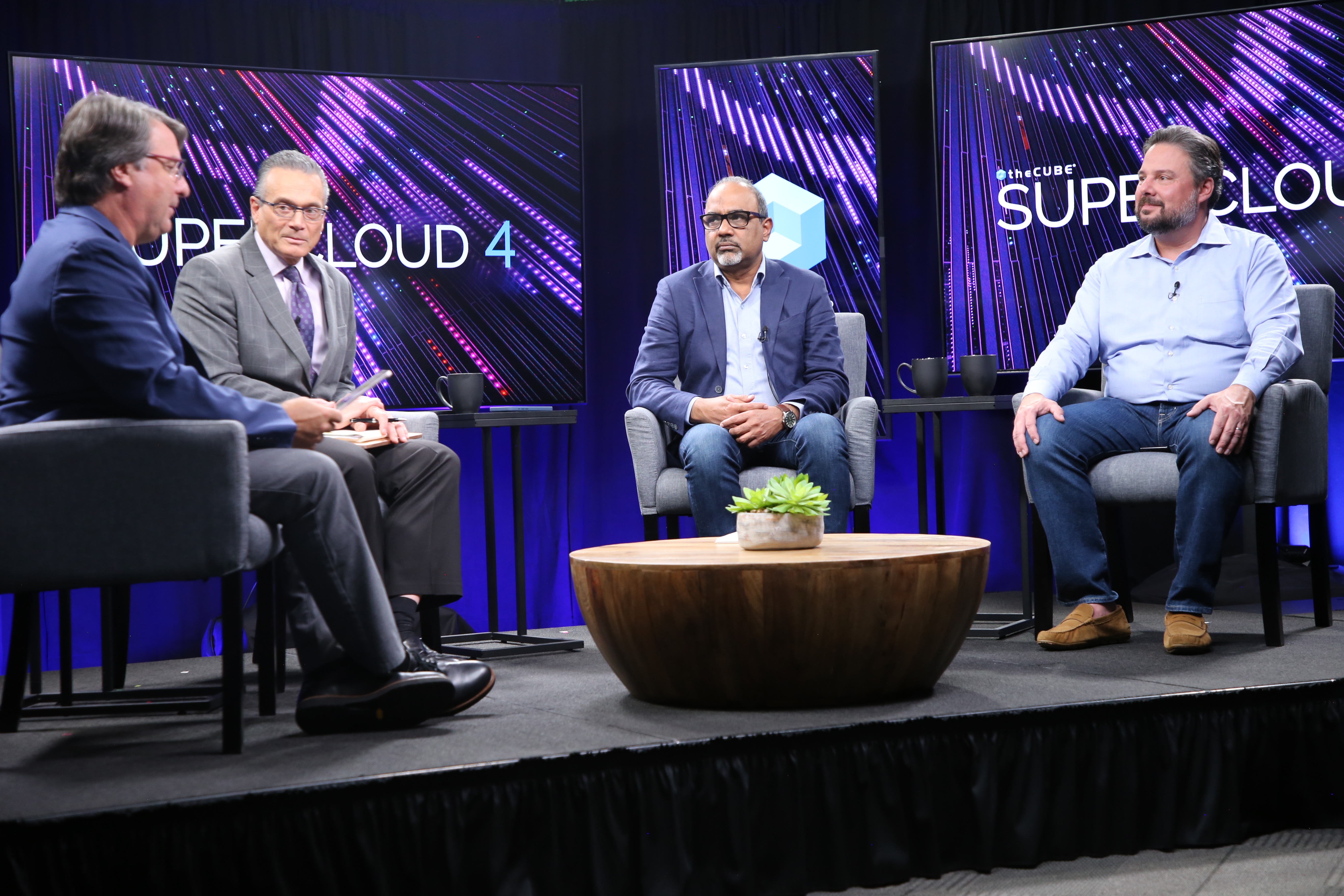 AI
AI
 AI
AI
 AI
AI
SiliconANGLE’s and theCUBE’s Supercloud 4 event, the fourth episode of a series dedicated to exploring the latest technologies in cloud computing, concluded its first day with a closing session that brought together industry experts to discuss the state of generative AI and its implications.
TheCUBE analysts Dave Vellante (pictured, second from left), John Furrier (left) and Rob Strechay (right) spoke with Sarbjeet Johal (second from right), technology strategist and founder and chief executive officer of Stackpane.
Large language models and the development of custom ChatGPT solutions are at the forefront of the AI landscape. But only a select few organizations are making substantial investments in these technologies, whether on-premises or in the cloud, and these investments often come with cloud operating models, according to Strechay.
“What we’ve been hearing — and what we continue to hear today — was that one platform is not going to fit all,” he said. “You’re going to see things consolidating from a data services and data features perspective in those data platforms. But that one platform will not dominate it all. And your data won’t all be consolidated down. You’re going to have to have governance and lineage and a number of other things across all of these different data platforms.”
The analysts shared breaking news and key insights during the segment, an exclusive broadcast on theCUBE, SiliconANGLE Media’s livestreaming studio.
A significant point of discussion was the divide between AI “haves” and “have-nots.” Despite AI being a part of the technological landscape for years, there’s still a stark contrast between companies effectively employing AI and those struggling to integrate it into their operations.
Microsoft Corp. and Google LLC were cited as examples of AI “haves,” with robust AI capabilities, while other contenders were yet to showcase their AI prowess in concrete numbers. “We’re going to see a bifurcation for the contenders from the pretenders,” Vellante said.
The financial performance of tech giants such as Google LLC parent Alphabet Inc. and Microsoft played a role in the conversation. Although Alphabet showed solid results in its AI endeavors, its stock price experienced a significant decline, raising questions about the transparency of AI investments in tech companies, according to Vellante.
In a conversation that touched upon AI’s portrayal in the media, its potential to boost productivity, and the challenges of AI adoption, Johal shed light on the nuanced reality of AI’s impact. In particular, he highlighted the importance of the “last mile” in AI and its significance in transitioning AI from experimentation to full-scale production.
“I think media is hyping the fear of AI into the masses,” he said, pointing out that recent events, such as the Hollywood writers’ strike, have contributed to this sensationalism.
But amidst the noise, the real value of AI lies in its ability to boost productivity. “All in all, I think the productivity boost is the No. 1 use case for people,” he said.
Discussing the broader context of productivity trends in the United States, the country has been declining in productivity for a number of years, Johal explained. However, he’s optimistic about AI’s role in reversing this trend.
“AI will let us come back, ramp up the productivity. That’s No. 1,” he added, underscoring the potential of AI to be a catalyst for economic growth and enhanced efficiency.
A key challenge with AI tech is the journey from AI experimentation to full-scale production. While many organizations are conducting proof of concepts and smaller AI projects, the “last mile” of AI, where accurate and predictable AI solutions are delivered at scale, remains a formidable challenge.
“That means like having the true, real use cases where you have that predictability and accuracy coming from the large language model,” Johal explained. This “last mile” represents the final, critical step in the AI journey, according to the analysts.
Generative AI, while promising, faces issues related to “hallucinations” or wrong answers, a challenge that needs to be addressed for AI to reach its full potential.
“We’re all fine with ChatGPT kind of lying to us every now and again and hallucinating and what have you,” Strechay said. “But I think when you start to get into certain cases like financial services, going and saying, “Hey, I recommend the stock to you,” there’s a human in the loop on that, because they can’t trust it to be fully autonomous in that way.”
Here’s the complete video interview, part of SiliconANGLE’s and theCUBE’s coverage of Supercloud 4:
Support our open free content by sharing and engaging with our content and community.
Where Technology Leaders Connect, Share Intelligence & Create Opportunities
SiliconANGLE Media is a recognized leader in digital media innovation serving innovative audiences and brands, bringing together cutting-edge technology, influential content, strategic insights and real-time audience engagement. As the parent company of SiliconANGLE, theCUBE Network, theCUBE Research, CUBE365, theCUBE AI and theCUBE SuperStudios — such as those established in Silicon Valley and the New York Stock Exchange (NYSE) — SiliconANGLE Media operates at the intersection of media, technology, and AI. .
Founded by tech visionaries John Furrier and Dave Vellante, SiliconANGLE Media has built a powerful ecosystem of industry-leading digital media brands, with a reach of 15+ million elite tech professionals. The company’s new, proprietary theCUBE AI Video cloud is breaking ground in audience interaction, leveraging theCUBEai.com neural network to help technology companies make data-driven decisions and stay at the forefront of industry conversations.